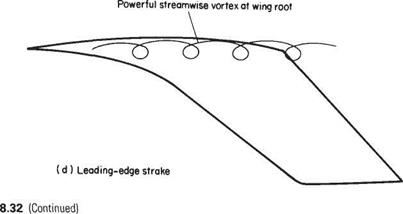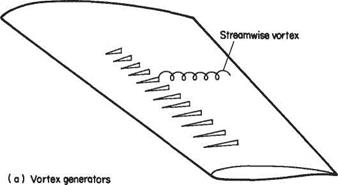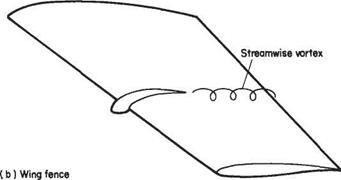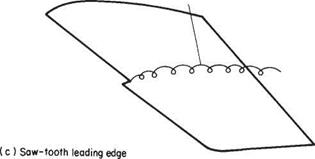Other methods of separation control
Passive flow control through the generation of streamwise vortices is frequently used on aircraft and other applications. Some of the devices commonly in use are depicted
in Fig. 8.32. Figure 8.32a shows a row of vortex generators on the upper surface of a wing. These take a variety of forms and often two rows at two different chordwise locations are used. The basic principle is to generate an array of small streamwise vortices. These act to promote increased mixing between the high-speed air in the main stream and outer boundary layer with the relatively low-speed air nearer the surface. In this way the boundary layer is re-energized. Vortex generators promote the reattachment of separated boundary layers within separation bubbles, thereby postponing fully developed stall.
Fixed vortex generators are simple, cheap, and rugged. Their disadvantages are that they cannot be used for active stall control, a technology now being used for highly manoeuvrable fighter aircraft; also they generate parasitic drag at cruise conditions where stall suppression is not required. These disadvantages have led to the development of vortex-generator jets (VGJ) whereby angled small jets are blown, either steadily or in a pulsatory mode, through orifices in the wing surface. The concept was first proposed by Wallis in Australia and Pearcey in the U. K.* primarily
|
|
|
|
Fig. 8.32
* R. A. Wallis (1952) ‘The use of air jets for boundary layer control’, Aerodynamic Research Laboratories, Australia, Aero. Note 110 {N-34736)’, H. H. Pearcey (1961) ‘Shock-induced separation and its prevention’, in Boundary Layer & Flow Control, Vol. 2 (edited by G. V. Lachmann), Pergamon, pp. 1170-1344.
![]()
|

for the control of shock-induced separation. More recently the concept has been reexamined as an alternative to conventional vortex generators[68].
Wing fences (Fig. 8.32b) and ‘vortilons’ act as a barrier to Upward flow on swept – back wings. They also generate powerful streamwise vortices. The saw-tooth leading edge (Fig. 8.32c) is another common device for generating a powerful streamwise vortex; as is the leading-edge strake (Fig. 8.32d). In this last case the vortex reenergizes the complex, three-dimensional, boundary-layer flow that develops along the wing-body junction.














